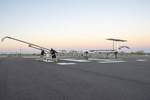Airbus successfully completes 2021 summer test flights for Zephyr HAPS satellite aircraft
The carbon fiber stratospheric UAV continues to demonstrate its capabilities for commercial and military customers, adding an additional 887 flight hours to the 2,435 stratospheric flight hours for Zephyr to date.

Photo Credit: Airbus
The composite Zephyr S unmanned aerial vehicle (UAV) has completed a successful 2021 test flight campaign in the U.S., Airbus (Munich, Germany) reports. The company’s final solar-powered high altitude platform system (HAPS) flight touched down on Sept. 13 in Arizona, ending what Airbus claims was the most ambitious and successful Zephyr flight campaign to date.
Zephyr S is a stratospheric UAV running exclusively on solar power via ELO-based solar cells, and is meant to provide persistent local satellite-like services with zero carbon emissions. Built with carbon fiber composites, it is 30% lighter than the Zephyr 7 and can be landed, re-equipped with next-generation payloads and re-deployed. It is also capable of flying autonomously from takeoff to landing and can be remotely operated from its ground control station.
This recent flight campaign had a clear customer focus, Airbus says, which was to demonstrate how Zephyr could be used for future operations, flying outside of restricted airspace and over airspace shared with commercial air traffic. Carrying an Optical Advanced Earth Observation system for the Zephyr (OPAZ) payload, Zephyr proved its operational value to provide instant, persistent and improved situational awareness.
“Working with Airbus and the Zephyr team during the 2021 flight campaign, significant progress has been made towards demonstrating HAPS as a capability. This summer’s activities represent an important step towards operationalizing the stratosphere,” says James Gavin, future capability group head at Defence Equipment & Support, the procurement arm of the UK Ministry of Defence.
The campaign consisted of six flights in total: four low-level test flights and two stratospheric flights. The stratospheric flights flew for around 18 days each, totaling more than 36 days of stratospheric flight in the campaign. This adds a further 887 flight hours to the 2,435 stratospheric flight hours for Zephyr to date, marking significant progress for fixed wing HAPS and is a step towards making the stratosphere an operational reality for its customers.
“Credible and proven ultra-persistence, stratospheric agility and payload interoperability underscore why Zephyr is the leader in its sector,” says Jana Rosenmann, head of unmanned aerial systems at Airbus. “It is a sustainable, solar-powered, ISR and network-extending solution that can provide vital future connectivity and earth observation to where it is needed.”
With its ability to remain in the stratosphere for months at a time, Airbus says Zephyr will bring new capabilities to both commercial and military customers. This includes improving disaster management, including monitoring the spread of wildfires or oil spills. It also enables persistent surveillance, tracing the world’s changing environmental landscape and will be able to provide communications to the most unconnected parts of the world.
Related Content
-
Novel dry tape for liquid molded composites
MTorres seeks to enable next-gen aircraft and open new markets for composites with low-cost, high-permeability tapes and versatile, high-speed production lines.
-
Infinite Composites: Type V tanks for space, hydrogen, automotive and more
After a decade of proving its linerless, weight-saving composite tanks with NASA and more than 30 aerospace companies, this CryoSphere pioneer is scaling for growth in commercial space and sustainable transportation on Earth.
-
PEEK vs. PEKK vs. PAEK and continuous compression molding
Suppliers of thermoplastics and carbon fiber chime in regarding PEEK vs. PEKK, and now PAEK, as well as in-situ consolidation — the supply chain for thermoplastic tape composites continues to evolve.
















